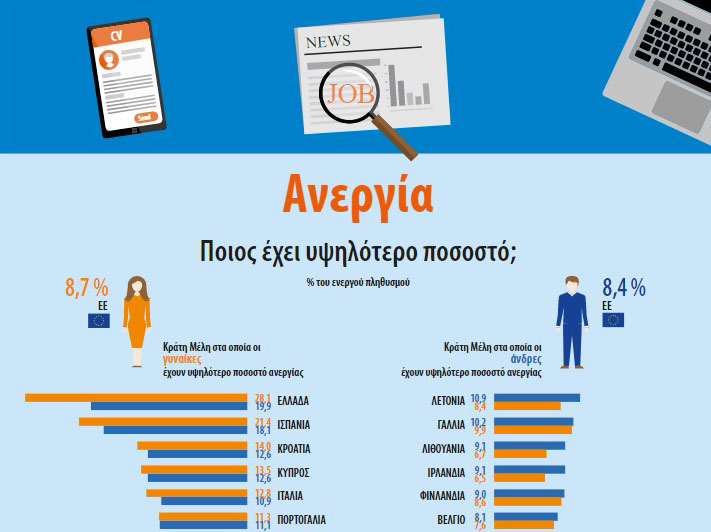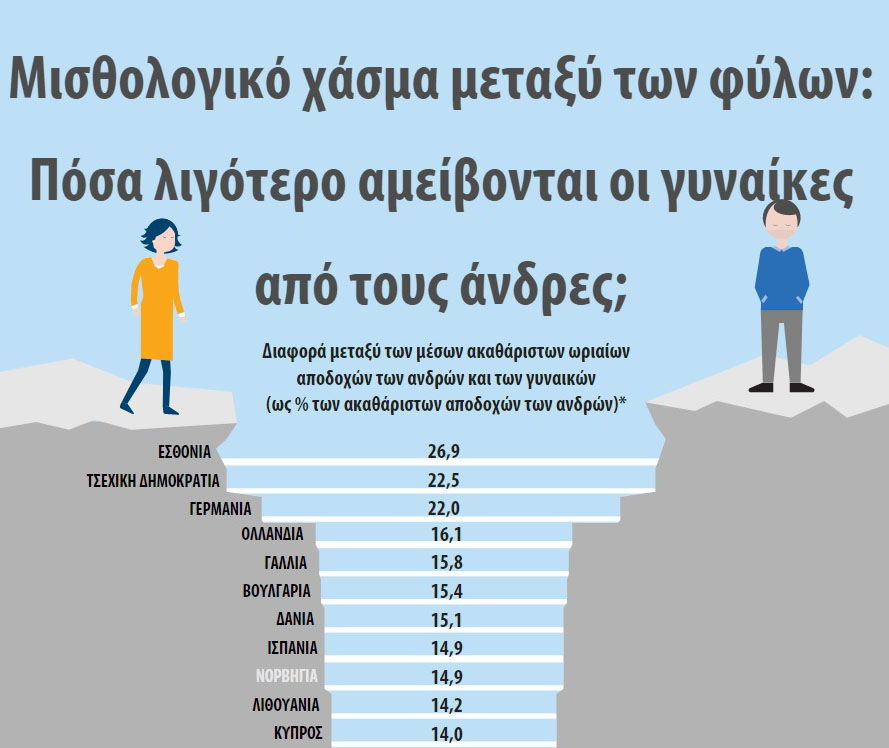Cypriots are kept at their weight… They are thinner than other Europeans, the second thinnest in Europe after the Italians.
What makes Cypriots less satisfied with their lives than other Europeans? Is Cyprus one of the worst countries in Europe for a woman to live? The Eurostat survey we have before us, entitled "Statistical Portraits" - released on the occasion of Women's Day on March 8 - may not answer this question, but it does provide some very interesting facts about her profile.
The umbilical cord
As can be seen in the graph, Cypriot women leave their paternal home one year earlier than κες mama men, and specifically at 26,7 years compared to 27,6 of men. Of course, the average European man leaves his paternal home at an older age than the Cypriot, at 30,4, while the average European woman at an older age than the Cypriot, at 27,8 , refuting the impressions. Nevertheless, there are countries where women and men leave their paternal home to start their own independent life much earlier. For example, in Denmark the woman leaves the paternal home at 20,7, while the young men at 21,3.
The wedding
European women put a "roll" at 30,1, on average, while men at 33,2. Cypriot women get married for the first time earlier, at almost 28, while men do shortly after 30.
In Austria women first have their first child, around 29, and get married a year later. This is also true in many other countries, such as Belgium, France, Denmark, the Czech Republic, Italy, Britain, Spain, etc.
The pension
Shortly before the age of 62, the Cypriot woman retires, a year later than the Cypriot man. In fact, Cypriot women work for four and a half years longer than the average European, who retires at 57,5 years (58 men). Iceland, Norway and Sweden have the highest retirement rates, ranging between 63 and 65, and apply to both men and women.
Alone or with children
In Europe, 7,7% of women aged 25-49 are single women with children. The corresponding percentage of men is only 1,1%. It is also noteworthy that in the category of older people over 65, the percentage of women living alone exceeds 40%, while that of men is below 20%.
In Cyprus, the percentage of women in the age group 25-49 who live alone with their children is 6,5% and men under 1%. Over the age of 65, 33,4% of women live alone, while the corresponding percentage for men is only 11,8%.
Good health
Cypriot women aged 16-44 state that they feel healthy or very healthy. The healthiest, according to their statements, in Europe at a rate of 94,5% (93,9% men)! In Europe the corresponding percentage of women is 86% (87% men). However, as Cyprus grows, this percentage decreases.
Between the ages of 45 and 64, 74% of Cypriot women (something similar applies to men) say they are healthy or very healthy. While at 65 and over the percentage of women who state that they have very good health is reduced to 36% (48% the equivalent of men).
What do they die from?
The death rate for Cypriot women is lower than the European average. Specifically, the Cypriot woman is more resistant to cancer than other European women, as she counts 140 deaths per 100 thousand women (200 deaths in Europe). 69 women per 100 thousand inhabitants die from heart diseases, with a European average of 94. 74 Cypriot women die from cerebrovascular diseases (79 the European average).
What life do they lead?
Finally, what quality of life do Cypriots have? How much do they drink? How much do they smoke and how much do they exercise? According to statistics, only 8,6% of Cypriot women drink alcohol compared to 23% of European women. 14,9% smoke compared to 15,8% of Europeans and 20,9% exercise against 26,2% of Europeans. However, they are among the thinnest in Europe, second thinnest after the Italians, with a body mass of 36,8% compared to 43,7% of the average European.
Clothes and travel
Cypriots appear to have different habits from other Europeans when it comes to using the internet. Only 9% say they buy event tickets online (38% in the EU), 11% buy household items (43% in the EU), 13% in music (43% in the EU) and 6% in electronic equipment (17% in the EU). EU). But it shows great interest in shopping for clothes and travel online! 61% say they buy clothes and shoes (68% in the EU) and 59% travel (51% in the EU).
Few Cypriots at the "top"
One third (33%) of senior executives in the EU are women. In Cyprus this percentage is one of the five lowest in Europe with a 26%. In no Member State can the corresponding percentage of women exceed 50%, but there are also very high percentages, such as in Latvia (47%), Poland and Slovenia (41%), Lithuania, Hungary and Sweden. (39%).
However, the interesting thing that we record for Cyprus is that in 2013 the index moves upwards and women increase in higher positions.
In Parliament
In Sweden, more than 46% of women hold Parliament. 42% in Finland, 40,2% in Belgium, 38,8% in Spain and 37,4% in Denmark.
The average in Europe is 29% and in Cyprus 17,9%. There are worse, as in Hungary, where women make up 10% of Parliament, Malta 14%, Latvia 17%, and we are once again at the bottom.
In order not to reset the data, of course, the progress made over the years is significant, considering that in 2003 we started with the representation of women in Parliament of the order of 11%. With some fluctuations we have reached today. It is important to maintain the percentage and raise it.
Who stays at home to take care of the children?
And yet, despite the opposite view, there are men who stay home, inactive, to care for children while women are in the labor market.
In fact, here Cyprus makes the difference in relation to the EU average.
Specifically, while in 2016 in the EU the percentage of men who chose to stay out of work to take care of children was 4,3%, in Cyprus it was more than double, reaching 9,6%. One could argue that this is due to the economic crisis and the fact that a large percentage of men have lost their jobs.
This may be partly true, but it is not a panacea, as this index, with some fluctuations, has remained stable since 2002.
The women's index on the other hand is down. In 2004, 76% of women remained inactive to care for children and the household. Today this percentage has decreased to 58%, while in 2014 it had reached 47%. There is a big gap with the women of Europe, who in only 30,7% choose to remain inactive in order to maintain their home and family. In Denmark, only 6,9% of women choose to stay home to care for children. Closer to Cyprus is Ireland, with our country having the worst index in this issue as well.
Cooking
When asked who does the daily cooking and housework, the gap between men and women in Cyprus is one of the highest in the EU at 54% (45% in the EU, 19% in Sweden), with women certainly being the ones who do the job…
In another very interesting question, who has the care and education of children, the gap is reduced to 21% and is even smaller than in the EU (24%). There are of course standard countries, such as Sweden, where the gap here is only 6%. In no country do men prevail over these two questions…
Remuneration gap: And something to be proud of
According to Eurostat indicators, the pay gap between men and women in Cyprus has decreased in the five years 2010-2015 and is even smaller than the European average!
In 2010 specifically, the pay gap was 16,8% in Cyprus, while in 2015 it fell to 14%. As much as in Spain.
Respectively in Europe it started in 2010 with 16,4%, increased in 2012 to 17,2 to take a downward trend again and return in 2015 to the levels around 2010, reaching 16,2%.
Of course, there are worse performances than in Cyprus, and in fact in advanced countries. In Austria, for example, the gender pay gap is 21,7%, up from 24% in 2015. The Czech Republic and the United Kingdom have a similar rate, while in Denmark the pay gap is 15,1%.
The table that shows the dip in the gap of the employment rate of men and women is also of great interest. In 2005 the difference in employment between the two sexes was 21,7%. In 2016 it fell to 9,7%, while in Europe it is higher and reaches 11,6%, although it started much lower a decade ago. This shows that gender now plays a smaller role in recruitment.
Source: Citizen
Article: Miranda Lysandrou, Nikolas Georgiou




